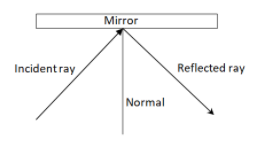
Answer
375.9k+ views
Hint: The main factor while choosing the activity is to prove that incident ray, reflected ray, and normal lie on the same plane. A clear understanding of the incident ray reflected ray and the properties of reflection will enable one to deduce an activity for this rule. When light is incident on a mirror or a reflective surface the light will bounce or reflect into the same medium.
Complete step-by-step solution:
Apparatus: Drawing board, Sheet of paper, laser light, plane mirror.
Procedure:
Place a sheet of paper on the drawing board. Place a plane mirror on the piece of paper and draw an outline of the mirror. Also, draw a normal to the mirror.
Now shine the laser light at an angle to the mirror such that it falls on the normal at the bottom of the mirror. If shined normal to the mirror, no incidence or reflected ray will be observed as the angle of incidence, in this case, is zero, thereby the angle of reflection is also zero.
When the laser light is incident on the mirror, it gets reflected at an angle to the normal.
We can easily observe that the incident ray, the reflected ray, and the normal at the point of incidence all lie in the same plane.
From this activity, it is observed that the normal, the line of incidence, and the reflected ray all lie on the same plane.

Note: This activity can also be used to determine that the angle of incidence is equal to the angle of reflection. Care must be taken while handling laser light. Do not point the laser source to your eyes as it can cause permanent damage. In the case of reflection another imperative property is that the angle of incidence is always equal to the angle of reflection.
Complete step-by-step solution:
Apparatus: Drawing board, Sheet of paper, laser light, plane mirror.
Procedure:
Place a sheet of paper on the drawing board. Place a plane mirror on the piece of paper and draw an outline of the mirror. Also, draw a normal to the mirror.
Now shine the laser light at an angle to the mirror such that it falls on the normal at the bottom of the mirror. If shined normal to the mirror, no incidence or reflected ray will be observed as the angle of incidence, in this case, is zero, thereby the angle of reflection is also zero.
When the laser light is incident on the mirror, it gets reflected at an angle to the normal.
We can easily observe that the incident ray, the reflected ray, and the normal at the point of incidence all lie in the same plane.
From this activity, it is observed that the normal, the line of incidence, and the reflected ray all lie on the same plane.

Note: This activity can also be used to determine that the angle of incidence is equal to the angle of reflection. Care must be taken while handling laser light. Do not point the laser source to your eyes as it can cause permanent damage. In the case of reflection another imperative property is that the angle of incidence is always equal to the angle of reflection.
Recently Updated Pages
How many sigma and pi bonds are present in HCequiv class 11 chemistry CBSE

Mark and label the given geoinformation on the outline class 11 social science CBSE

When people say No pun intended what does that mea class 8 english CBSE

Name the states which share their boundary with Indias class 9 social science CBSE

Give an account of the Northern Plains of India class 9 social science CBSE

Change the following sentences into negative and interrogative class 10 english CBSE

Trending doubts
Fill the blanks with the suitable prepositions 1 The class 9 english CBSE

Which are the Top 10 Largest Countries of the World?

Give 10 examples for herbs , shrubs , climbers , creepers

Difference Between Plant Cell and Animal Cell

Difference between Prokaryotic cell and Eukaryotic class 11 biology CBSE

The Equation xxx + 2 is Satisfied when x is Equal to Class 10 Maths

Change the following sentences into negative and interrogative class 10 english CBSE

How do you graph the function fx 4x class 9 maths CBSE

Write a letter to the principal requesting him to grant class 10 english CBSE



